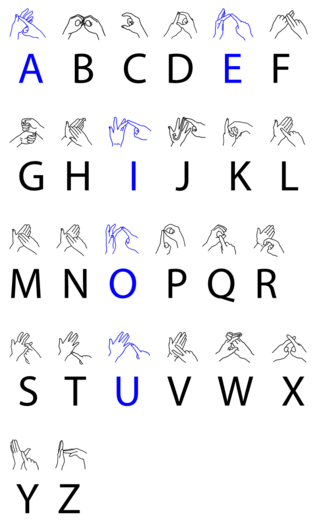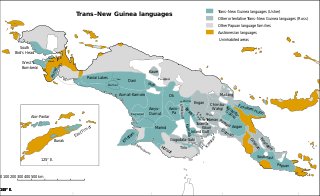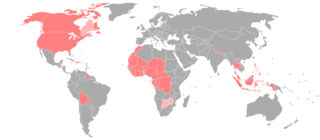Related Research Articles

British Sign Language (BSL) is a sign language used in the United Kingdom and is the first or preferred language among the deaf community in the UK. While private correspondence from William Stokoe hinted at a formal name for the language in 1960, the first usage of the term "British Sign Language" in an academic publication was likely by Aaron Cicourel. Based on the percentage of people who reported 'using British Sign Language at home' on the 2011 Scottish Census, the British Deaf Association estimates there are 151,000 BSL users in the UK, of whom 87,000 are Deaf. By contrast, in the 2011 England and Wales Census 15,000 people living in England and Wales reported themselves using BSL as their main language. People who are not deaf may also use BSL, as hearing relatives of deaf people, sign language interpreters or as a result of other contact with the British Deaf community. The language makes use of space and involves movement of the hands, body, face and head.

Trans–New Guinea (TNG) is an extensive family of Papuan languages spoken on the island of New Guinea and neighboring islands, a region corresponding to the country Papua New Guinea as well as parts of Indonesia.
Auslan is the sign language used by the majority of the Australian Deaf community. The term Auslan is a portmanteau of "Australian Sign Language", coined by Trevor Johnston in the 1980s, although the language itself is much older. Auslan is related to British Sign Language (BSL) and New Zealand Sign Language (NZSL); the three have descended from the same parent language, and together comprise the BANZSL language family. Auslan has also been influenced by Irish Sign Language (ISL) and more recently has borrowed signs from American Sign Language (ASL).

British, Australian and New Zealand Sign Language (BANZSL) is the language of which British Sign Language (BSL), Auslan and New Zealand Sign Language (NZSL) may be considered dialects. These three languages may be considered dialects of a single language (BANZSL) due to their use of the same grammar and manual alphabet and the high degree of lexical overlap. The term BANZSL was coined by Trevor Johnston and Adam Schembri.

Irish Sign Language is the sign language of Ireland, used primarily in the Republic of Ireland. It is also used in Northern Ireland, alongside British Sign Language (BSL). Irish Sign Language is more closely related to French Sign Language (LSF) than to BSL, though it has influence from both languages. It has influenced sign languages in Australia and South Africa, and has little relation to either spoken Irish or English. ISL is unique among sign languages for having different gendered versions due to men and women being taught it at different schools all over Ireland.
Manually Coded English (MCE) is a type of sign system that follows direct spoken English. The different codes of MCE vary in the levels of directness in following spoken English grammar. There may also be a combination with other visual clues, such as body language. MCE is typically used in conjunction with direct spoken English.

Education in Papua New Guinea is managed through nineteen provinces and two district organisational units. It is tuition-free and attendance is not compulsory.
Adam Kendon was one of the world's foremost authorities on the topic of gesture, which he viewed broadly as meaning all the ways in which humans use visible bodily action in creating utterances including not only how this is done in speakers but also in the way it is used in speakers or signers when only visible bodily action is available for expression. At the University of Cambridge, he read Botany, Zoology and Human Physiology, as well as Experimental Psychology for the Natural Sciences. At the University of Oxford, he studied Experimental Psychology, focusing on the temporal organization of utterances in conversation, using Eliot Chapple's chronography. Then he moved to Cornell University to study directly with Chapple on research leading to his D. Phil. from Oxford in 1963. His thesis topic—communication conduct in face-to-face interaction—spelled out the interests he would pursue in subsequent decades. He is noted for his study of gesture and sign languages and how these relate to spoken language. After completing the D. Phil., he accepted a position in the Institute of Experimental Psychology at Oxford, where he worked in a research group with Michael Argyle and E.R.W.F. Crossmann. He initially focused on sign systems in Papua New Guinea and Australian Aboriginal sign languages, before developing a general framework for understanding gestures with the same kind of rigorous semiotic analysis as has been previously applied to spoken language.
A contact sign language, or contact sign, is a variety or style of language that arises from contact between deaf individuals using a sign language and hearing individuals using an oral language. Contact languages also arise between different sign languages, although the term pidgin rather than contact sign is used to describe such phenomena.
Manually coded languages (MCLs) are a family of gestural communication methods which include gestural spelling as well as constructed languages which directly interpolate the grammar and syntax of oral languages in a gestural-visual form—that is, signed versions of oral languages. Unlike the sign languages that have evolved naturally in deaf communities, these manual codes are the conscious invention of deaf and hearing educators, and as such lack the distinct spatial structures present in native deaf sign languages. MCLs mostly follow the grammar of the oral language—or, more precisely, of the written form of the oral language that they interpolate. They have been mainly used in deaf education in an effort to "represent English on the hands" and by sign language interpreters in K-12 schools, although they have had some influence on deaf sign languages where their implementation was widespread.
East New Guinea Highlands is a 1960 proposal by Stephen Wurm for a family of Papuan languages spoken in Papua New Guinea that formed part of his 1975 expansion of Trans–New Guinea.

Papua New Guinea, a sovereign state in Oceania, is the most linguistically diverse country in the world. According to Ethnologue, there are 840 living languages spoken in the country. In 2006, Papua New Guinea Prime Minister Sir Michael Somare stated that "Papua New Guinea has 832 living languages ."
Sinasina is a term used to refer to for several Chimbu–Wahgi language varieties of Tabare Rural LLG, Simbu Province, Papua New Guinea. The term 'Sinasina' as a language name is an exonym. Speakers of the varieties of this region instead refer to their languages with tok ples vernacular languages endonyms, including: Dinga, Gunangi, Kebai, Kere, Kondo, Nimai, Tabare. The Kere community also has a deaf sign language, Sinasina Sign Language.
A village sign language, or village sign, also known as a shared sign language, is a local indigenous sign language used by both deaf and hearing in an area with a high incidence of congenital deafness. Meir et al. define a village sign language as one which "arise[s] in an existing, relatively insular community into which a number of deaf children are born." The term "rural sign language" refers to almost the same concept. In many cases, the sign language is known throughout the community by a large portion of the hearing population. These languages generally include signs derived from gestures used by the hearing population, so that neighboring village sign languages may be lexically similar without being actually related, due to local similarities in cultural gestures which preceded the sign languages. Most village sign languages are endangered due to the spread of formal education for the deaf, which use or generate deaf-community sign languages, such as a national or foreign sign language.
Enga Sign Language is an apparent village sign language among the Tato Enga people in Enga province, Papua New Guinea. It was reported in 1980 in three articles by Adam Kendon, based on ethnographic films of three signers in the upper valley of the Lagaip River, but with reports of wider use in the surrounding region. Its current status is unknown, as no more recent information is available.

American Sign Language (ASL) developed in the United States, starting as a blend of local sign languages and French Sign Language (FSL). Local varieties have developed in many countries, but there is little research on which should be considered dialects of ASL and which have diverged to the point of being distinct languages.
The deaf community in Australia is a diverse cultural and linguistic minority group. Deaf communities have many distinctive cultural characteristics, some of which are shared across many different countries. These characteristics include language, values and behaviours. The Australian deaf community relies primarily on Australian Sign Language, or Auslan. Those in the Australian deaf community experience some parts of life differently than those in the broader hearing world, such as access to education and health care.
Sinasian Sign Language (SSSL) is a village sign language of the Sinasina valley in Chimbu Province, Papua New Guinea. This language is used by approximately 3 deaf and 50 hearing individuals, including members of the Kere community. SSSL was first encountered and reported by linguist Samantha Rarrick in 2016. Documentation efforts are ongoing.
Proto-Trans–New Guinea is the reconstructed proto-language ancestral to the Trans–New Guinea languages. Reconstructions have been proposed by Malcolm Ross and Andrew Pawley.

Sir Joseph Nombri was a politician, administrator and diplomat in Papua New Guinea (PNG). He played an important role in events leading up to PNG's independence in 1975 and later became the country's ambassador in Tokyo.
References
- 1 2 3 4 5 ISO request part 1
ISO request part 2 - 1 2 Radio Australia report
- ↑ EMTV report Archived 2016-03-04 at the Wayback Machine
- ↑ Kendon, Adam. "A description of a deaf-mute sign language from the Enga Province of Papua New Guinea with some comparative discussion." Semiotica 32.1-2 (1980): 81-118.
- ↑ Rarrick, Samantha. "Sinasina Sign Language (Chimbu, Papua New Guinea) - Language Snapshot" Language Documentation and Description Vol 19 (2020) 79-86.